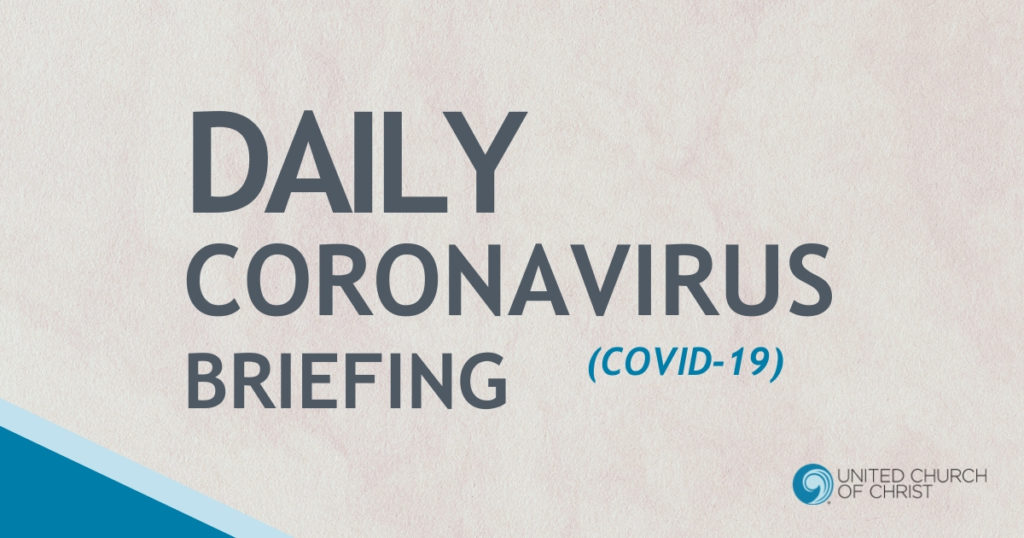New CDC COVID-19 Guidelines as States Reopen, Cases Spike
United Church of Christ – Wider Church Ministries
Humanitarian Development Team
Coronavirus (COVID-19) Daily Briefing
Barbara T. Baylor, MPH – Temporary Health Liaison
COVID-19 Cases Spike as States Reopen; CDC Issues New Guidelines
Many Americans are acting as if COVID-19 has “gone away” or has lessened its grip on the United States. Unfortunately, that is not the case.
All 50 states are somewhere in the process of reopening. At Memorial Day observances and at protests over the death of George Floyd, many people abandoned basic public health COVID-19 prevention messages; specifically, to wear face masks and practice social distancing.
Public health specialists fear the United States is heading for a nasty second wave of COVID-19 infections this fall.
Already last week, 14 states saw an uptick of more than 25 percent in new COVID-19 infections. “The U.S. is still seeing roughly 20,000 new COVID-19 cases a day,” said Centers for Disease Control (CDC) Director Robert Redfield, testifying before the House Appropriations Committee on June 4, 2020.
When asked by Rep. Rosa DeLauro (D-Conn), member of the House Appropriations Committee, if there was any evidence that COVID-19 has become less contagious, Redfield simply said, “No.”
The current spike in new cases of COVID-19 has prompted the CDC to issue new guidelines for Americans on “how to navigate daily life.”
Jay C. Butler, CDC’s Deputy Director of Infectious Diseases and COVID-19, underscored the importance of the new protocol, saying “that every activity that involves interacting with others has some risk. The new guidelines are necessary so that people may make decisions about which activities they may be able to resume and what level of risk they may have to accept.”
If people’s behavior does not change, says The Health Institute for Metrics Evaluation, the U.S. death toll could reach between 133,201 and 290,222 (mean of 169,890) by October.
The new CDC guidelines, published on the CDC’s website, are divided into two sections – “deciding to go out” and “considerations for events and gathering.”
Here is a brief snapshot of the new guidelines.
CDC notes: Because COVID-19 virus circulation varies in communities, these considerations are meant to supplement – not replace – any state, local, territorial or tribal health and safety laws, rules and regulations with which gatherings must comply.
1. Before meeting up with friends, consider the number of people, amount of space and length of time you plan to engage.
A rule of thumb: The more closely you interact with others, the longer the interaction lasts and the higher the number of people involved all directly increase the risk of the coronavirus spreading.
2. Opt for the outdoors at restaurants.
Indoor spaces are more risky than outdoor spaces, Indoors, it is harder to keep people apart and there’s less ventilation. CDC recommends wearing face coverings when not eating or drinking and remaining six feet apart even while outside.
3. Here is a sampling of other considerations. See the CDC guidelines for much more!
– Using the gym – don’t share items that cannot be cleaned or sanitized. Refrain from high fives or elbow bumps, which involve getting closer than six feet.
– If the library is open, see if curbside is available.
– If you want to gather with friends for a cookout, as much as possible use single-serve options and remind guests to wash their hands before and after eating.
4. Consider how quickly COVID-19 is spreading in your community before hosting gatherings.
The higher the level of community transmission in the area that the gathering is being held, the higher the risk of COVID-19 spreading during a gathering.
Check to see how many cases are appearing in your city or state before deciding whether it’s safe to attend a birthday party, wedding or concert.
Visit the CDC’s community page for more suggestions on travel, schools reopening, using public transit and more.
COVID-19, which knocked on our doors about five months ago, has infected more than 2 million people in the United States and has caused the deaths of almost 116,000, according to the June 14 data compiled by Johns Hopkins University’s COVID-19 tracker.
Public health experts say that states need to re-emphasize safety measures that can slow the spread of the virus, including washing hands frequently and thoroughly, maintaining a physical distance of at least six feet from others, and wearing a face mask.
Understanding the risks and how to adopt different prevention measures can help you protect yourselves and others against the virus.
Related News
Growing Weary
In December 1964 during a speech in Harlem, Fannie Lou Hamer declared: “And you can always...
Read MorePlanning for Earth Month: Resources for Congregations
April is Earth Month, and for congregations, it can be a great time to further discern how...
Read MoreBodily Autonomy Means Every-BODY
Advocacy and Action for Women's and Gender Justice Local events stir thoughts and...
Read More


